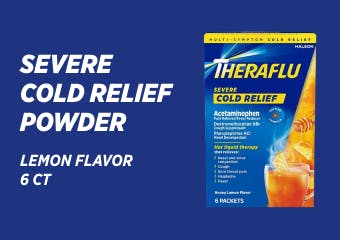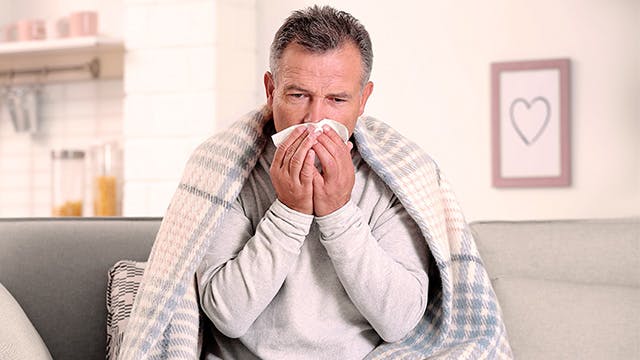Cough
Cold
Usually
Allergies
Occasionally
Aches & pains
Cold
Occasionally
Allergies
Never
Fatigue & weakness
Cold
Occasionally
Allergies
Rarely
Itchy eyes
Cold
Rarely
Allergies
Usually
Sneezing
Cold
Usually
Allergies
Usually
Sore throat
Cold
Usually
Allergies
Rarely
Runny nose
Cold
Usually
Allergies
Usually
Fever
Cold
Rarely
Allergies
Never
Cold
Adults usually get two to three colds each year, whereas children have less developed immune systems and are at risk to get more colds throughout the year.3 Symptom onset for the common cold is gradual, whereas system onset for the flu is abrupt. You likely have a cold virus if you are experiencing the following symptoms:3,6
- A runny nose (common)
- Mild to moderate coughing
- Nasal congestion (common)
- Slight body aches
- Headaches (rare)
- Sneezing (common)
- Sore throat (common)
- Fever (rare)
Flu
While you can contract the flu all-year long, the viruses usually peak during the fall and winter.4 October is when the number of flu cases start to increase, and February is the month in which case numbers peak.4 If you are experiencing the following symptoms, you might have a flu virus:6
- Coughing (common)
- Sore throat (sometimes)
- Runny nose (sometimes)
- Body aches (usual)
- Headaches (common)
- Fatigue (usual)
- Fever (usual)4
- Some people may experience vomiting or diarrhea4
Allergies
Allergies can occur during any time of the year. There are also different types of allergies like hay fever, allergic reactions to food, allergic reactions to bug bites, and allergic reactions to medication.5 If you have any of the following symptoms for one of these types of reactions, you might be dealing with allergies:
Hay fever5
- Sneezing
- An itchy runny nose
- Itchy watery eyes
- A stuffy nose
Food allergy5
- An itchy or tingly mouth
- Swelling in the face
- Swelling of the throat
- Hives
- Trouble breathing
If you experience any of these symptoms, seek medical attention immediately.
A bug bite allergy5
- The area where you were bit is swollen
- Itching or hives on your body
- Coughing
- Chest tightness
- Breathing trouble
If you experience any of these symptoms, seek medical attention immediately.
A medication allergy5
- Hives or itchy skin
- Swelling in the face
- Trouble breathing
If you experience any of these symptoms, seek medical attention immediately.
The duration and frequency of symptoms may also help you tell the difference. The symptoms of a cold typically last three to 14 days, and the symptoms of a flu virus usually last between five to seven days, but allergy symptoms last longer, usually for weeks, or as long as the person is exposed to an allergen. Colds tend to occur in the winter, and they often take several days to show up after exposure to a virus. The flu viruses usually peak in October and stay in high numbers through May. With seasonal allergies, the onset of symptoms occurs immediately after exposure to either indoor or outdoor pollens in the winter, spring, summer or fall.
Because allergies, flu viruses, and colds are very different illnesses, they warrant different types of over-the-counter treatments. Avoiding allergens, if possible, can also help to reduce your allergy symptom burden.





